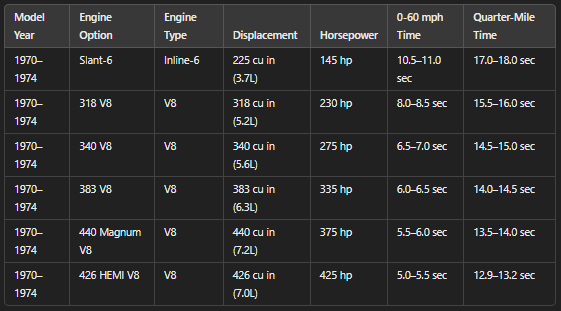The Dodge Challenger (1970–1974), part of the golden age of muscle cars, continues to be a symbol of performance, style, and power. Introduced to the automotive world by Chrysler, this iconic vehicle captured the hearts of muscle car enthusiasts and remains a classic collector's item today. From its stunning design to its powerful engine options, the Challenger stands as a true testament to the era's automotive engineering.
A Bold Introduction to Muscle Car Culture
Debuting in 1970, the Dodge Challenger was created to compete with Ford's Mustang and Chevrolet's Camaro. As part of Chrysler’s E-body platform, the Challenger was designed to combine the best of performance and luxury. Unlike its competitors, the Challenger offered a more refined driving experience with a spacious cabin and a distinctive design, making it more than just a high-performance vehicle.
With sleek, aggressive lines and a muscular stance, the first-generation Challenger quickly became one of the most sought-after muscle cars. Available in a hardtop coupe and a convertible body style, the Challenger delivered both in terms of style and performance.
Engine Options: Power at Your Fingertips
One of the standout features of the 1970–1974 Dodge Challenger was its diverse engine lineup. Whether you were after a thrilling drive or a more economical choice, the Challenger had something for everyone:
- Slant-6 Engine: The base engine, a 225-cubic inch inline-six, was ideal for those looking for a more budget-friendly option, while still offering decent performance.
- 340 V8 Engine: For those seeking more muscle, the 340-cubic inch V8 engine delivered impressive acceleration and a thrilling driving experience.
- 383 V8 Engine: A popular option for enthusiasts, the 383-cubic inch V8 engine provided a balance between power and drivability, making it one of the best-selling engine options.
- 440 Magnum V8: For the performance-minded, the 440 Magnum V8 engine offered 375 horsepower, making it a favorite among muscle car lovers.
- 426 HEMI V8: The crown jewel of the Challenger lineup, the 426 HEMI V8 engine, produced 425 horsepower and was a beast on the road. Its raw power and incredible acceleration made it an instant legend.
Performance and Handling
Beyond the engine options, the first-generation Dodge Challenger was engineered for excellent handling and road grip. Its front and rear suspension system, combined with an optional performance package, made it perfect for drag racing or cruising on the highway. The Challenger was designed with a performance-first mindset, which is why it became so popular among enthusiasts and racers alike.
The Challenger R/T (Road/Track) model was the ultimate performance variant, combining the 440 Magnum V8 or the 426 HEMI engine with performance-tuned suspension, enhanced braking, and sportier trim. The R/T model was capable of hitting impressive 0-60 times and quarter-mile speeds, making it a serious contender in the muscle car wars.
first-generation Dodge Challenger (1970–1974), showcasing key engine options, their horsepower, and performance metrics:
Key Highlights:
- Slant-6 Engine: Offered the most economical choice but still provided decent performance for daily driving.
- 340 V8: This engine was a favorite among performance enthusiasts, delivering a solid mix of power and drivability.
- 426 HEMI V8: The ultimate engine in the Challenger lineup, known for its incredible power and acceleration, making it a legend in the muscle car world.
These times are approximate and can vary based on conditions, weight of the car, and modifications. The 426 HEMI V8 remains the most revered engine for its outstanding performance in both acceleration and top speed, making it a standout in the muscle car era.
Design and Features: The Best of Both Worlds
The Dodge Challenger was a head-turner, with its bold, aggressive design that stood out from the crowd. The long, sculpted hood and wide stance made it look fast even when parked. Inside, the Challenger offered a comfortable and spacious cabin, with a choice of high-end materials and sporty trim options.
In addition to the standard models, Dodge also offered special editions and optional features like rear spoilers, hood scoops, vinyl roof treatments, and racing stripes, all of which added to the car's unique flair.
The End of an Era: The 1974 Model
The first-generation Dodge Challenger came to an end in 1974, as the muscle car era began to fade due to rising insurance costs, stricter emissions regulations, and the oil crisis. While it was short-lived, the Challenger's legacy has only grown stronger over the years. Its rare and powerful engine options, coupled with its timeless design, make it a highly desirable collector’s item today.
Collecting the First-Generation Dodge Challenger
As a collector's item, the 1970–1974 Dodge Challenger is in high demand. The most coveted models are those equipped with the 426 HEMI V8 engine, though other well-maintained versions, especially the Challenger R/T models, also command high prices. When purchasing a first-generation Challenger, it's important to consider the vehicle's originality, condition, and history. Restored models with low mileage tend to fetch premium prices, while projects in need of restoration can also be found at a more affordable price.
Why the First-Generation Dodge Challenger Still Matters
The Dodge Challenger (1970–1974) is more than just a muscle car; it is a symbol of an era when American automakers pushed the limits of performance and style. With its range of powerful engines, standout design, and lasting appeal, the Challenger remains one of the most iconic muscle cars of all time.
Whether you’re a car enthusiast, a collector, or someone who appreciates automotive history, the Dodge Challenger will always be remembered as a classic. Its power, beauty, and timeless design continue to inspire and captivate drivers and collectors worldwide.
Keywords:
- Dodge Challenger
- First-generation Dodge Challenger
- 1970 Dodge Challenger
- Muscle car
- Challenger R/T
- Dodge Challenger 426 HEMI
- Challenger performance
- 1970s muscle cars
- Dodge Challenger engine options
- Collector’s car



.jpg)
0 Comments